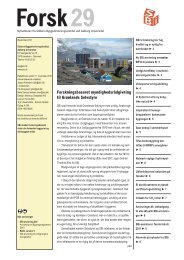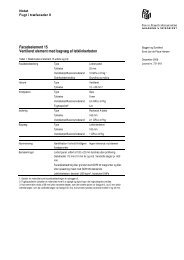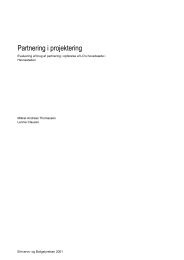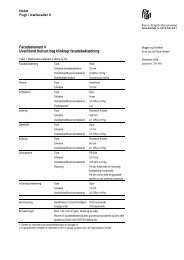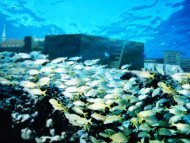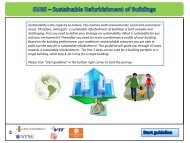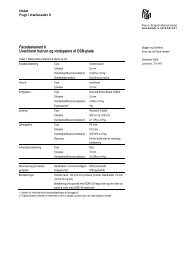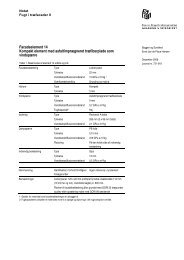Mould growth on building materials - Statens Byggeforskningsinstitut
Mould growth on building materials - Statens Byggeforskningsinstitut
Mould growth on building materials - Statens Byggeforskningsinstitut
You also want an ePaper? Increase the reach of your titles
YUMPU automatically turns print PDFs into web optimized ePapers that Google loves.
2.4.10 Paecilomyces<br />
From the genus Paecilomyces Bain. two species are found in water damaged <strong>building</strong>s, P.<br />
variotii Bain. and P. lilacinus (Thom) Sams<strong>on</strong>, with the first being the most abundant.<br />
P. variotii is capable of growing <strong>on</strong> very low nutrient substrates as optical lenses, whereas P.<br />
lilacinus seems to prefer protein rich media 270 .<br />
P. variotii can produce the str<strong>on</strong>gly cytotoxic mycotoxins patulin and viriditoxin 65 as well the<br />
metabolites: ferrirubin, variotin, fusigen and indole-3-acetic acid 25 .<br />
2.5 Biomarkers of mould <str<strong>on</strong>g>growth</str<strong>on</strong>g><br />
As earlier menti<strong>on</strong>ed, not all spores are viable and hence a number of methods for measuring<br />
chemical and molecular biological markers are needed. These methods can also provide<br />
much faster measurements for mould determinati<strong>on</strong> and significantly better quantificati<strong>on</strong>.<br />
For determinati<strong>on</strong> of moulds, four different principles can be used for material samples or air<br />
filters:<br />
• Determinati<strong>on</strong> of the activity of fungal enzymes. Here two methods have been used:<br />
i) Fluorescein diacetate hydrolytic activity (by determining fluorescein) will both detect the<br />
presence of bacteria and/or moulds in wooden samples 125,313 ; ii) Determinati<strong>on</strong> of the activity<br />
of β-N-acetylglucosaminidase 314 (a enzyme in the chitinase partway) which is now<br />
commercially available as the Mycometer Test TM . Both methods have the advantage that<br />
the samples can be incubated for as l<strong>on</strong>g time as wanted, and hence a very high sensitivity<br />
can be obtained as many molecules of reactant can be obtained from each enzyme<br />
molecule. However these methods <strong>on</strong>ly detect functi<strong>on</strong>al enzymes.<br />
• Chemical markers, which can be genus, species, or isolate specific. These include:<br />
i) extracellular polysaccharides from Penicillium and Aspergillus 30,315 ;ii) 18:2ωphosphorlipid<br />
fatty acids 314 ;iii) β-glucan from the cell wall, also being an important inflammatory<br />
marker 37,39 ; iv) mycotoxins or sec<strong>on</strong>dary metabolites who are species specific<br />
47 ; v) MVOC's in the air 41,316 ; vi) chitin from the cell wall 317 ; and finally the cell membrane<br />
material ergosterol 318,319 •<br />
. All these metabolites can principally be detected using<br />
various analytical methods as described for metabolites in secti<strong>on</strong> 2.6.<br />
PCR-based methods, detecting specific parts of the fungal DNA, enabling even isolate<br />
rec<strong>on</strong>diti<strong>on</strong> if needed, and also recently quantitati<strong>on</strong> 229 . These methods will undoubtedly<br />
be very important in the future especially when the DNA-chip technology comes<br />
down in price.<br />
• Bioassay detecti<strong>on</strong>, either by detecti<strong>on</strong> cytotoxicity 320,321 or more specific mode of acti<strong>on</strong>,<br />
as the protein translati<strong>on</strong> inhibiti<strong>on</strong> which is highly selective against trichothecenes<br />
322 . Such methods give health relevant data but do not give any informati<strong>on</strong> <strong>on</strong> the<br />
producing mould.<br />
All these methods are significantly faster than cultivati<strong>on</strong> techniques and can also detect<br />
dead spores and mycelia, and will be the predominant methods in the future.<br />
2.5.1 Ergosterol<br />
Ergosterol (Erg) is the predominant compound in the fungal cell membrane, making it a suitable<br />
indicator for fungal <str<strong>on</strong>g>growth</str<strong>on</strong>g>, although it should be noted that also some amoebae and<br />
green algae are capable of producing Erg 323 .<br />
Page 24



